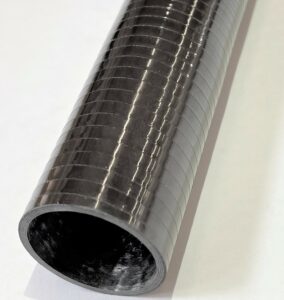Carbon Composite, Composite Rods and Tubes, Custom composites
Unidirectional Vs. Twill Carbon in Wrapped Carbon Tubes: Cosmetic or Functional?

When you think of a carbon-fiber, you probably envision the woven, cross-hatch look found in so many consumer products. However, many of our rods and tubes are made with unidirectional carbon, where the carbon fibers are all oriented in the same direction. But why? Is there truly an advantage to twill carbon, other than just looking cool? The answer, of course, is “it depends.” Twill carbon fabric and unidirectional carbon fabric have different properties that make them excellent choices for different applications.
Twill Carbon Fabric
Twill Carbon Fiber Fabric is what most people think of when they say “Carbon Fiber.” It is a geometric weave that looks like it is two-toned in color because of the way the fibers reflect the light. Both unidirectional and twill carbon fabric use the same carbon fibers, but the twill is woven, so the fibers are oriented at 90-degrees (perpendicular) to each other. The weave provides more drapability: the ability for it to conform to different three-dimensional shapes. Additionally, the resin content in prepreg (pre-impregnated) twill fabric is higher because there are more gaps in the material that must be filled.

Benefits of Twill:
- Drapability: Twill fabric can conform to three-dimensional shapes because the fibers weave through one another and bend over and under each other. Twill follows curves better than unidirectional carbon fabric.
- Impact protection: The weave, with fibers lying perpendicularly across one another, can resist impact and deformation a bit better than unidirectional fibers.
Drawbacks of Twill:
- Lower stiffness: Compared to unidirectional fabric, twill is not as stiff because the fibers lie perpendicular to each other and because they weave over and under each other do not lie perfectly flat.
- Cost: Twill carbon fabric is more complicated to manufacture because it must be woven, so it is three-to-four times more expensive than unidirectional carbon fabric on average.
Unidirectional Carbon Fabric
Unidirectional fabric has all the fibers nestled together and lying in the same direction. When we layer a sheet of unidirectional fiber on top of another unidirectional fiber sheet, we can oppose the layers to have fibers running anywhere between 0-degrees and 90-degrees to the layers before and after. This layering of unidirectional fibers in different orientations to one another provides for infinitely custom configurations of a wrapped carbon tube. The finish on a unidirectional wrapped carbon tube or a unidirectional pultruded rod or tube is flat black and can be easily ground or painted.

Benefits of Unidirectional Carbon:
- Stiffness: Unidirectional rods and tubes have higher stiffness-to-weight ratio than twill because the carbon fibers are all lying flat and oriented in the same direction. If your goal is a light, stiff tube, unidirectional carbon is the best option.
- Cost: Unidirectional carbon is commonly used for structural applications and is easier to manufacture than twill, resulting in products that are much less expensive than twill.
- Customization: Unidirectional fabric can be laid up in a multitude of different orientations so the properties of the tube fit end-use goals as efficiently as possible. We can build layers for deflection, hoop strength, impact resistance, and more.
Drawbacks of Unidirectional Carbon:
- Difficult to drape: Unidirectional carbon fabric does not easily conform to multiple curves in a three-dimensional product.
- Appearance: A unidirectional carbon rod or tube is plain black.
As you can imagine, the right choice for a composite rod or tube is most often unidirectional carbon. For our wrapped carbon tube customers who love the look of twill but do not require the properties of twill, we can often do a final wrap of the tube in a layer of twill. This will give a tube that great, woven finish without multiple layers of expensive fabric. The underlying layers can be customized for maximum benefit with unidirectional, twill, or a combination of both.
At Goodwinds Composites, we offer you not just choices, but the knowledge and expertise to help you make the right choice for your specific application. Whether it’s the strength and stiffness of unidirectional carbon or the aesthetic appeal of twill, we’ve got you covered. Contact us today to discuss your project and find the perfect carbon solution for your needs.
